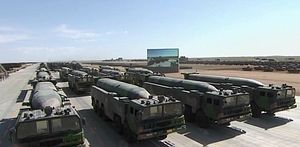China’s People’s Liberation Army Rocket Force (PLARF) held a combined massive ballistic and cruise missile exercise over the weekend, one day before a major parade to celebrate the People’s Liberation Army’s 90th anniversary.
The drill, which took place in Inner Mongolia, near the PLA’s Zhurihe military base, involved at least three types of missile systems and the launch of at least 20 missiles.
According to U.S. government sources with knowledge of the exercise who spoke to The Diplomat, the PLARF employed four DF-26C intermediate-range ballistic missiles (IRBM), ten DF-16A medium-range ballistic missiles, and six CJ-10 land attack cruise missiles in the live fire portion of the exercise.
At least three surface-to-air missile systems were involved in the exercise as well, including the HQ-6, HQ-16, and HQ-22. The HQ-22 was seen publicly for the first time at the PLA’s 90th anniversary parade.
The ballistic and cruise missiles simulated a long-range strike on a mock up of a U.S. Terminal High Altitude Area Defense (THAAD) site and also struck ground-based models of U.S. F-22 Raptor stealth fighters, one source added.
The exercise is one of the largest recent PLARF exercises of its kind and one of the first publicly reported uses of the DF-26C IRBM in an exercise. Little public information exists on the DF-26C, which is a secretive PLARF IRBM capable of precision strikes with both conventional and nuclear payloads and is thought to have been first deployed in 2014 or earlier.
The DF-16 MRBM is also a secretive program, with the missiles having first been displayed publicly at China’s September 2015 parade to commemorate the 70th anniversary of the end of the Second World War.
Earlier this year, new images of the DF-16, including never-before-seen configurations, appeared on several Chinese websites. The MRBM serves a conventional payload precision-strike role with a range in excess of 1,000 kilometers and at least three known variants exist.
The CJ-10, meanwhile, is a standoff cruise missile, capable of striking targets at a range in excess of 1,500 kilometers, according to U.S. Department of Defense’s 2017 report on China’s military capabilities.
Combined, the exercise likely tested the PLARF’s ability to stage a coordinated precision-strike salvo attack against defensive installations like a THAAD battery across multiple missile crews.
A single THAAD battery, while effective against short-, medium-, and intermediate-range incoming targets, can be easily overwhelmed by a saturation strike.
The PLARF’s combined exercise came one day after North Korea’s second-ever test of an intercontinental-range ballistic missile, the Hwasong-14. The PLARF’s choice of a simulated THAAD installation for the exercise was likely intended to convey a message to the United States.
Beijing has long opposed the deployment of a THAAD system in South Korea, where it will be deployed in the southern part of the country, in Gyeongsanbuk-do.
China fears that the system’s associated AN/TPY-2 X-band radar will be able to diminish the effectiveness of its strategic nuclear deterrent by improving the United States’ ability to discriminate real intercontinental-range ballistic missile warheads from decoys and other penetration aids.

































